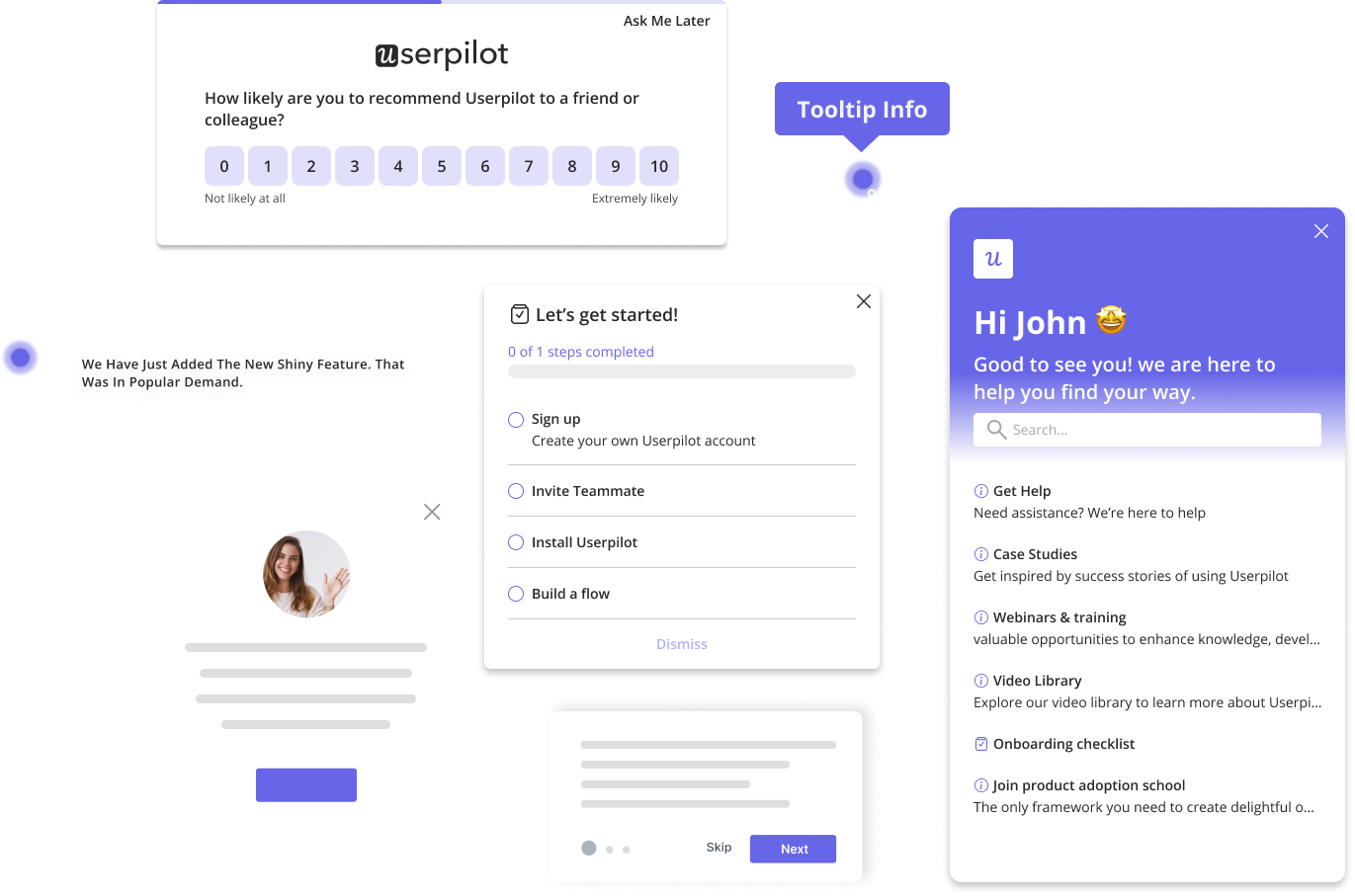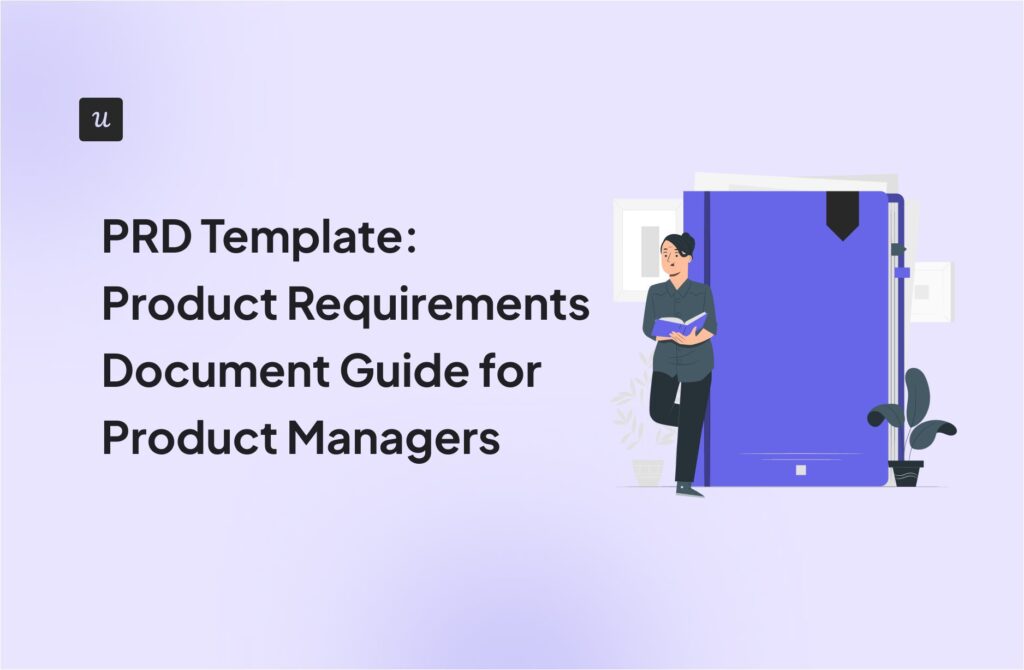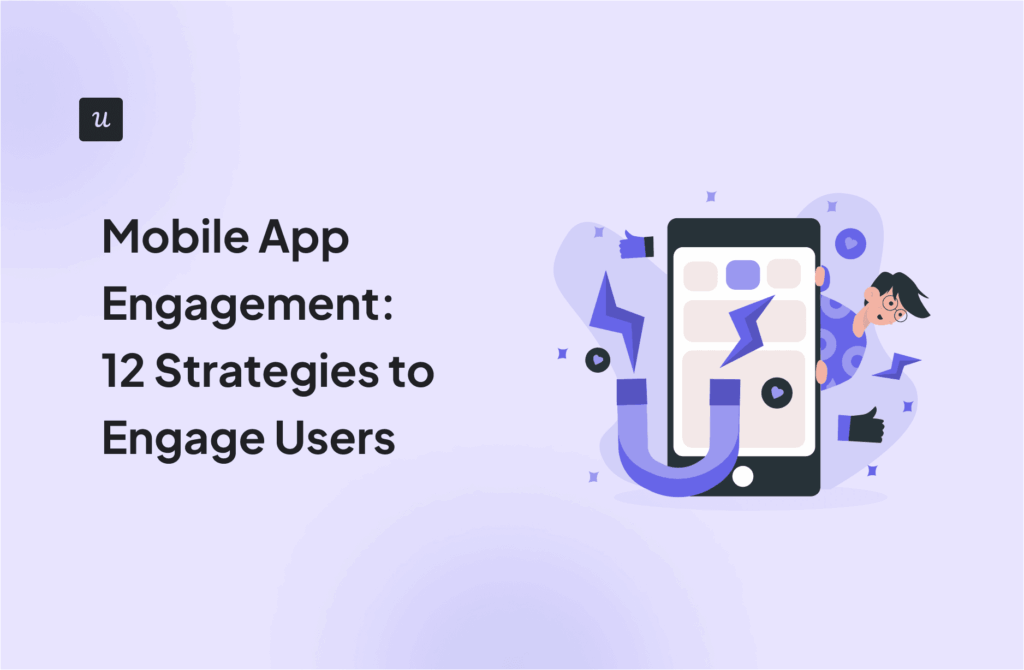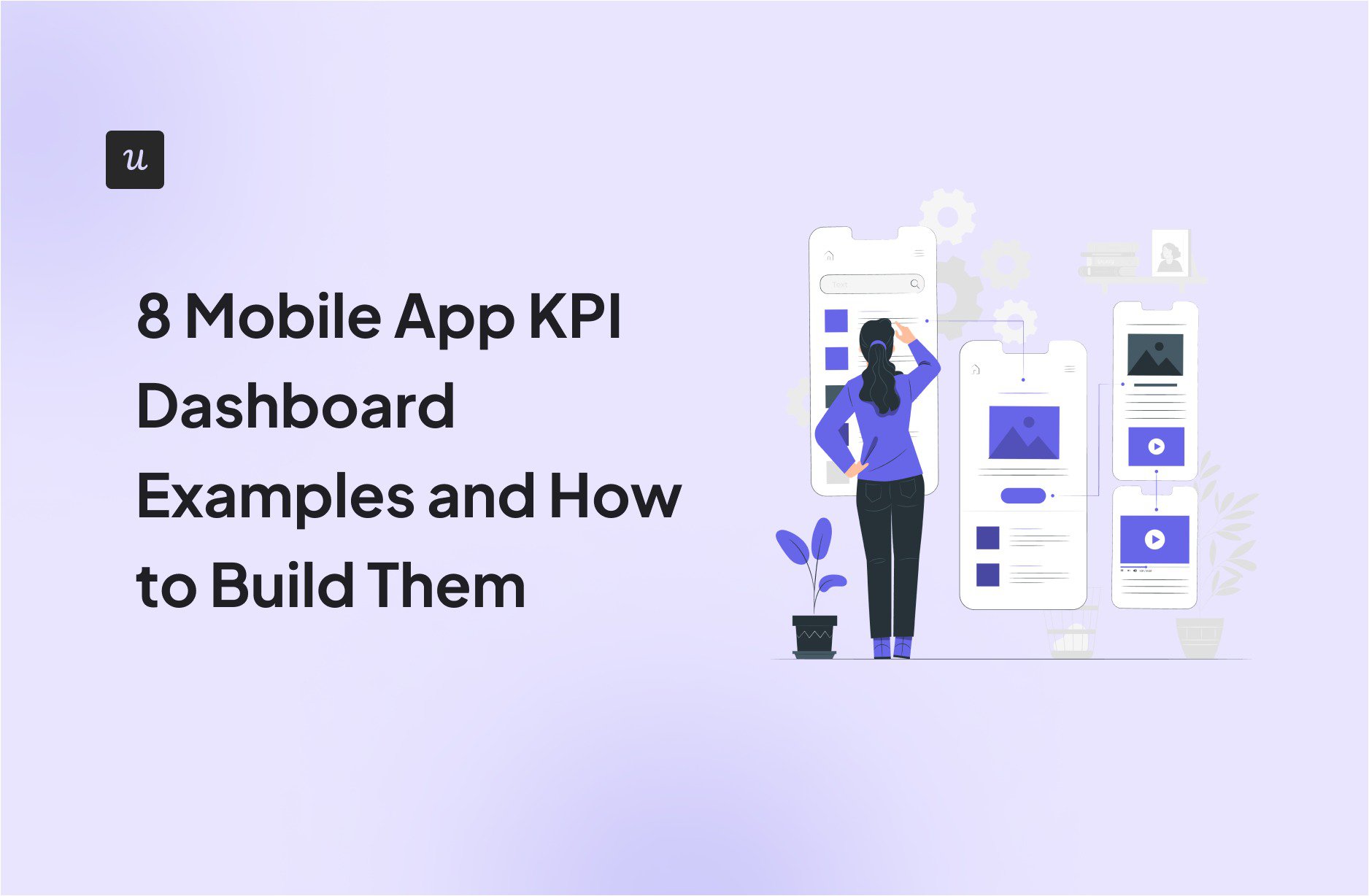
Your mobile app KPI dashboard is supposed to answer questions, not create more. But when user engagement drops and every tool tells a different story, it’s hard to know what’s actually going wrong.
Google Analytics says one thing, your product management dashboard says another, and customer support data adds more noise than clarity.
In this guide, I’ll walk through how to build a mobile app KPI dashboard that actually helps you track what matters, plus 8 real dashboard examples for different use cases!
Try Userpilot Now
See Why 1,000+ Teams Choose Userpilot
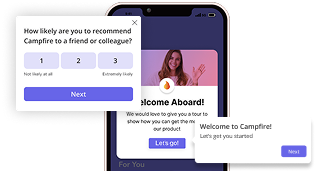
What is a mobile app KPI dashboard?
A mobile app KPI dashboard is a centralized analytics tool that tracks key performance indicators (KPIs) to measure user engagement, app performance, and monetization.
It helps my team track real-time mobile app analytics metrics like user engagement, feature adoption, and performance issues to make ROI influenced decisions.
How to build a mobile app KPI dashboard
For me, it always starts with defining what success looks like for our app.
- Are we aiming for rapid user growth in the short term?
- Is the medium-term goal to build a loyal, engaged user base?
- Or are we looking at long-term monetization through subscriptions or in-app purchases?
And that’s the next critical question I always ask myself: “So what?” If tomorrow’s report shows 50% 30-day retention, what does that mean? What action does it trigger? Exploring user behavior is one thing, but with KPIs, we must be ready to act.
If you’re still figuring out your app’s purpose and haven’t quite defined those success metrics yet, don’t worry. Sometimes, it helps to start with a few fundamental metrics to get the ball rolling. For example, I often look at:
- Average Sessions per User: Calculated as (total logins in a month) / (number of users). This gives me a sense of overall engagement.
- Average Sessions per User per Day: Simply (Average Sessions per User) / (number of days in the month). As we improve the app, I’d expect this number to trend upwards, indicating users are finding more value in it daily.
- Monthly Active Users (MAU) or Daily Active Users (DAU): A classic metric for understanding the overall reach and growth of our user base.
Now, it’s important to remember that while improvements to the app should ideally lead to increases in these metrics, it’s not always a straight line. Sometimes, a spike in sessions could indicate frustration, like users repeatedly trying and failing to complete a task. That’s why context is crucial.
The next step is finding the right tool. There’s a whole landscape out there, from no-code analytics platforms with drag-and-drop builders to more specialized solutions.
The key is to identify what you need: Are you just looking for a way to visualize data, or do you need a tool that handles both data tracking and dashboard creation? There are even tools tailored for engineering metrics or specific product team needs. It depends on your specific use case.
Now, let’s get to the examples!
8 Mobile app KPI dashboard examples for different use cases
2022 global data volume hit 101 zettabytes, more than double that in 2019. We’re drowning in data, but it’s just noise without a clear mobile KPI dashboard.
A good analytics dashboard isn’t just about tracking numbers. It helps product managers, growth teams, and UX designers understand user behavior, app performance, and retention trends.
Below are eight essential dashboard examples built for different use cases. Whether you need to track mobile app performance, analyze user engagement, or optimize acquisition, these will help you build a dashboard that actually drives results.
#1 In-app flow engagement dashboard
From my perspective, watching users drop off at the last step of onboarding, or worse, abandon checkout with no context, is a sign we need better visibility. This dashboard helps us see exactly where users hit friction so we can fix it fast.
Here’s what I track:
- Interaction status (Shown, Completed, Dismissed): This tells me whether users even saw the flow, finished it, or bounced out midway.
- Step breakdown: I can pinpoint exactly which step users struggle with so we’re not guessing what went wrong.
- Filters by segment, company, OS, or time period: This helps us spot patterns across different user groups, like how enterprise users versus freemium users behave in onboarding.
- Navigation UX insights: If users are skipping steps or bouncing around, we know the flow isn’t intuitive. These signals help us identify poor navigation design.
Who is this for? Product teams, UX designers, and growth folks who care about improving user journeys.
When we see drop-offs, we act. We redesign the flow, add a nudge, or tweak the message. No guesswork. Just data-backed decisions.

#2 Mobile screen view and event dashboard
When we launch something new, I want to know more than just “Did users see it?” I care about what screens they visit, where they tap, and which pages get ignored. This dashboard helps me unpack user activity patterns, so I’m not left guessing why engagement is flat.
Here’s what I track:
- Most viewed screens: Shows where users spend the most time and the parts of the app that draw attention.
- Tagged screen breakdown: This helps me understand interaction depth. I can see what’s getting clicked, what’s not, and where drop-offs happen.
- Active users and companies: Useful for measuring user engagement across segments or accounts.
- Average views per user: Tells me how often users revisit key screens.
- Segmentation filters: I can drill down by user type, company, category, or time period to track behavior trends over time.
Who’s this for? Product managers, UX designers, and marketing teams. Anyone trying to improve engagement and understand how users navigate the app.
I’ve used this dashboard to spot buried features, flag low-performing screens, and fix navigation UX issues before they hurt conversion. It helps us act on what users actually do, not just what we expect.

#3 Mobile app analytics dashboard for tracking user behavior
When user behavior doesn’t match our expectations, this dashboard helps me see what’s really going on. It lets me move past gut instinct and base decisions on real user behavior data.
Here’s what I track:
- Tag events: I monitor taps, swipes, and gestures to understand how users interact with key features.
- Trends reports: These help me spot engagement changes over time and assess the impact of recent updates.
- Funnels: I use these to visualize where users drop off during onboarding, signups, or feature flows.
- User journey tracking: This shows how users move through the app and where they hit friction.
Who’s this for? Product teams, UX researchers, and data analysts who need to improve feature adoption and app functionality, streamline user flows, and boost mobile app engagement.
I’ve used this dashboard to uncover dead ends, broken experiences, and unexpected blockers that would have gone unnoticed in standard reports.

#4 Mobile app performance dashboard
When performance slips, the mobile app experience takes a hit. Users won’t tolerate app crashes, lag, or slow load times. I use this dashboard to catch those issues before they damage retention or app store ratings.
Here’s the mobile app performance metrics I track:
- App load time: How quickly the app opens on different devices and networks.
- Crash reports: Frequency and causes of crashes by OS, version, or device.
- API latency: Response speed from backend services.
- Error rates: Failures in logins, payments, or feature usage.
This dashboard is best for engineering and DevOps teams. It keeps the app running smoothly, helps prioritize bug fixes, and gives early signals before users start churning.

Use observability dashboards to monitor crash statistics, session stability, and platform-specific errors that impact user experience.
#5 User acquisition and conversion dashboard
From what I’ve seen, not all installs are created equal. A spike in downloads doesn’t mean much if users never sign up or stick around. That’s why I use this dashboard to track which channels actually bring in high-intent users.
Here’s what I’m looking at:
- App downloads by source to see where installs are coming from.
- Cost per install (CPI) to monitor spending efficiency.
- Conversion rate from install to registration or activation.
- Customer acquisition cost (CAC) to understand the total cost to acquire engaged users.
- Attribution data to identify which sources (ads, organic, referrals) drive the most value.
Bonus tip: If you’re on iOS, App Store Connect gives you direct access to acquisition and monetization metrics like app units, in-app purchases, and revenue trends.

Source: Apple – Download and view reports
This is key for growth teams, marketing, and user acquisition specialists who need to tie campaign spending to actual user engagement.
Why it matters: You can’t scale efficiently if you don’t know which marketing campaigns are working. This dashboard stops the guesswork.

Source: SlideTeam
#6 Mobile app retention dashboard
When installs are high but users stop showing up after day one, that’s where this dashboard steps in. I use it to track whether users are actually sticking around and which cohorts existing users are most engaged.
Here’s what I look at:
- Retention rate: How many users return after their first session.
- Daily and monthly active users (DAU and MAU): Helps me spot drops in ongoing engagement.
- DAU/MAU ratio: My go-to metric for measuring product stickiness.
- Cohort analysis: I compare user retention by signup date, campaign, or behavior.
Who’s this for? Product managers like me, along with lifecycle marketers and success teams for tracking churn risks.
If users drop off after onboarding, this dashboard helps uncover what went wrong and which touchpoints need fixing.

#7 A/B testing and experimentation dashboard
When conversion rates are stalling or drop-offs spike after a redesign, I turn to this A/B testing dashboard. It gives my team the data to decide which version actually performs better, before we commit to a full feature rollout.
Here’s what I look at:
- Key metrics like conversion rate, click-through rate, and time in app.
- Variant performance: Which version is converting better?
- Segmentation: Filter by user type, device, or region for clearer insights.
Who’s this for? Product teams, UX designers, growth marketers, and data analysts running experiments.
Instead of guessing what works, we rely on real results to optimize onboarding flows, features, and messaging.

#8 User sentiment and feedback dashboard
Even when the metrics look okay, I still want to know how users feel. That’s where this dashboard comes in. It helps us move beyond the numbers and into actual sentiment, what users love, what frustrates them, and what makes them leave.
Here’s what I’m tracking:
- Net Promoter Score (NPS) to gauge loyalty and recommendation intent.
- Customer Satisfaction Score (CSAT) after key interactions.
- In-app survey responses to gather feedback on updates, usability, and overall experience.
This one’s valuable for product managers, UX designers, and customer success teams who need direct input from users.
Quantitative data shows what’s happening; sentiment data tells us why. I’ve caught churn risks early just by spotting a dip in NPS or a pattern in survey comments.

Top mobile app metrics you should track
Besides the above dashboard examples, when I’m looking at how our app’s doing, there are a few important mobile app KPIs I pay close attention to.
These help me understand the full user journey, from finding us to sticking around and, hopefully, contributing to our bottom line. Here’s what’s usually on my radar:
- Acquisition Metrics tell me how new users are finding us through metrics like Cost Per Install (CPI), Install Rate, and Organic Discovery.
- Engagement Metrics help me understand how users are interacting with the app once they’ve downloaded it, looking at things like Retention Rate, Session Length, Screens per Session, and Push Notification Opt-in Rate.
- Conversion Metrics show me if users are taking valuable actions within the app, using metrics like In-App Purchase Rate, Subscription Rate, and Event Completion.
- Monetization Metrics, like Return on Ad Spend (ROAS), help me gauge the financial return on our advertising efforts.
- Finally, User Feedback and Sentiment Metrics, such as App Store Ratings and Reviews, give me direct insights into what users think of the app.
These are the metrics that usually give me a solid picture of how our app is performing across the board. They help me understand what’s working, what’s not, and where we need to focus our efforts to keep growing and improving.
Need to build mobile app KPI dashboards?
If you’re tired of piecing together scattered reports and conflicting data, it’s time to get a dashboard that actually works. With the right mobile app analytics dashboard like Userpilot, product managers, growth teams, and engineers can make data-driven decisions that move the needle.
As Dean Lindsay, Product Marketing Manager at Third Bridge, puts it:

Struggling to keep up with your mobile app users? With Userpilot, you can create intuitive mobile app KPI metrics and dashboards that provide clear insights into user behavior, engagement, and retention. Book a free demo with Userpilot and see how easy it is to build no-code mobile app KPI dashboards.
FAQ
What is the KPI for apps?
A mobile app KPI measures user engagement, retention, and revenue. Important KPIs include weekly active users, customer lifetime value, and in-app purchases. Businesses track mobile app marketing KPIs to improve user satisfaction and growth.
What is a dashboard in a mobile app?
A mobile app KPI dashboard tracks key performance indicators like app downloads, session duration, and feature adoption. It helps teams analyze app data and optimize user engagement for their target audience.
How to measure the performance of an app?
Mobile performance metrics like app load time, crash reports, and API response time help monitor stability. User engagement metrics, app session intervals, and even app store reviews and ratings show user satisfaction and retention trends.

